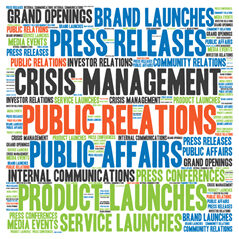The Secrets of Public Relations

Article based on excerpt from On Target: The Book on Marketing Plans by Tim Berry and Doug Wilson

Public Relations involves a variety of programs designed to maintain or enhance a company's image and the products and services it offers. Successful implementation of an effective public relations strategy can be a critical component to a marketing plan.
A public relations (PR) strategy may play a key role in an organization's promotional strategy. A planned approach to leveraging public relations opportunities can be just as important as advertising and sales promotions. Public relations is one of the most effective methods to communicate and relate to the market. It is powerful and, once things are in motion, it is the most cost effective of all promotional activities. In some cases, it is free.
Marketing |
Public relations |
|
Marketing promotes the transfer of goods and services from the producer and provider to the consumer. |
Public relations helps an organization and its publics adapt mutually to each other. |
|
Marketing's immediate goal is sales. |
Public relations' immediate goal is mutual understanding or positioning of the organization with its publics. |
|
Marketing's implicit goal is profit. |
Public relations' implicit goal is positive perceptions and predispositions. |
|
Marketing's measure of success is the number of sales and/or the revenue it generates. |
Public relations' measure of success is expressed public opinion or other evidence of public support. |

The success of well executed PR plans can be seen through several organizations that have made it a central focus of their promotional strategy. Paul Newman's Salad Dressing, The Body Shop, and Ben & Jerry's Ice Cream have positioned their organizations through effective PR strategies. Intel, Sprint and Microsoft have leveraged public relations to introduce and promote new products and services.
Similar to the foundational goals of marketing, effective public relations seek to communicate information to:
- Launch new products and services.
- Reposition a product or service.
- Create or increase interest in a product, service, or brand.
- Influence specific target groups.
- Defend products or services that have suffered from negative press or perception.
- Enhance the firm's overall image.
- The result of an effective public relations strategy is to generate additional revenue through greater awareness and information for the products and services an organization offers.
According to Landor Associates, 45 percent of a brand's image can be attributed to what it says and how it says it. Furthermore, 75 percent of consumers cite brand awareness as a major influencer in making their buying decision, and consistent brands are worth 20 percent more than those who aren't consistent.

Goals and Objectives
Good strategy begins with identifying your goals and stating your objectives. What are the goals and objectives behind your public relations strategy and can they be measured and quantified?
Each of these areas may reflect the goals your public relations campaign may seek to accomplish.
"It's important to remember the PR is a slow and steady approach. Don't expect to see results overnight," Montgomery said. "Building brand awareness and name recognition takes time, but it provides a solid base for your business to build upon the future as you have a larger budget for marketing, advertising, etc."

Press relations
Communicating news and information of interest about organizations in the most positive light.
The purpose of the news release is to connect with the media. In fact, the news release is the expected first communication with a media outlet. Perhaps you are looking for a story, interview, or a TV appearance -- the news release is the right place to start. However, even if your company meets the above criteria there is no guarantee that the media will use your release.
One question remains: Why are press releases still relevant, considering the sea of information now available online? There are a few reasons:
1. Authority: The very sea of information available causes some problems for your audience, in terms of what content can be trusted. Press releases are de facto statements of record for an organization, and as a result, they convey credibility and are perceived as being official, verifiable – by both professional media and the public.
2. Packaging: Well written press releases tell the whole story – the who, what, where, when, why and how – within a single message. They’re well suited for the ever-diminishing attention span of audiences.
3. Portability: Press releases are meant to be reproduced, shared, and quoted, removing any barriers or concerns about copyright that may cause your audience to hesitate.
What should we ask ourselves:
- What results do we hope to produce from our news release?
- What audience will my news release speak to?
- Is there anything unusual or noteworthy about the release our company will issue?
- In a stack of dozens of news releases, is there something about my news release that would catch the attention of the media?
- How will our company distribute the release (wires, mail, fax, email, etc.)?

Product and service promotion
If you’re planning to launch a new product or service at your small business, recognize this: Marketing that product or service in a highly fragmented media world has become trickier than ever.
Not all sales promotion is successful. For whatever reason, some promotions fail to capture the interest of prospective clients. While this may occasionally be the result of a mediocre product or service, more often than not the cause of this failure can be attributed to the campaign itself. To effectively motivate customers into doing business with your organization, your sales promotion strategy should include five elements:
- A Target Audience Over the course of a lifetime, loyal customers spend upwards of 10 times the amount spent by average customers.
- Measurable Goals There’s no denying the importance of setting goals. In fact, in a study performed by the Harvard MBA program, those who made and recorded clear goals went on to earn on average 10 times the amount of those who didn’t.
- Limited Availability Behavioral psychologists have found that human beings tend to assign greater value to things they perceive as being scarce. In a classic study performed in 1975, researchers had participants assign perceived value to identical cookies located in two identical jars. The only difference between the two jars was that one held 10 cookies, while the other held only two. The study discovered that while there was no apparent difference between the cookies or the jars, participants assigned greater value to the jar of two cookies.
- Sufficient Promotion Your promotion is an effort to draw customer attention to your organization’s product or service. But what about drawing attention to the promotion itself? In order for a promotion to be effective, it needs to be seen and understood by the same target audience identified back in point number-one.
- Value When all is said and done, the customer is interested in just one thing from your organization: value. If your sales promotion doesn’t offer your prospective clients real value, then all of the limited-time offers and targeted marketing in the world isn’t going to make your sales promotion a success.

Firm communications
Promoting a better and more attractive understanding of the organization with internal and external communications.
Key communication skills
Useful communication skills for building positive interpersonal relationships include:
- active listening
- understanding non-verbal signals
- maintaining eye contact
- assertiveness
- being mindful of people's individual space
- using positive body language
- dealing with different points of view.
Personal awareness skills that help with communication include:
- understanding the benefits of a positive attitude
- awareness of how others perceive you
- self-confidence
- presentation - dressing appropriately for different occasions.
You can use these techniques when you are talking, writing, or using your creativity in any way.

Lobbying
Communicating with key individuals to positively influence legislation and regulation.
As we continue to dig into the results, we’re uncovering insights with highly practical application for lobbyists, advocates, writers, promoters, and business owners (both large and small). Let’s look at ways that has proven to be successful for lobbyists, but read with an eye on promotion.
1. Legislators Respond in (Un)expected Ways to Grassroots Tactics
The ultimate grassroots influence result is behavior change of your influence prospect. We need to get their agreement “early and often.”
2. Social Media is Important, But it Produces Limited Results (For Now)
Grassroots professionals who are spending more time on email communications are spending less time on face-to-face communication. We found that email use correlates negatively with personal meeting investment. In other words, email is being used by some groups to replace, rather than supplant, effective face to face communications.
3. Hate to Break it to You…But The Size of Your Database Does Not Predict Success
We found that the size of an organization’s grassroots database (the average database size was just over 23,000) did not predict legislative success.
4. You’re Probably Defining Success Wrong
We believe it is extremely important to ascertain what grassroots professional deem as “success.” We have good news and bad news. “Activity” (a.k.a. doing stuff) is still used to define success, with 54.6 percent describing it by the number of activities undertaken. Forty-one percent (41 percent) stated that achievement, such as changed perceptions, behaviors, and thus, influence, represents success.

Internal feedback
Feedback occurs when an environment reacts to an action or behavior. For example, ‘customer feedback’ is the buyers’ reaction to a company’s products, services, or policies; and ’employee performance feedback’ is the employees’ reaction to feedback from their manager – the exchange of information involves both performance expected and performance exhibited.
5 Reasons Why Feedback is Important
- Feedback is always there.
- Feedback is effective listening.
- Feedback can motivate.
- Feedback can improve performance.
- Feedback is a tool for continued learning.
PR should be the bloodline of all businesses!
